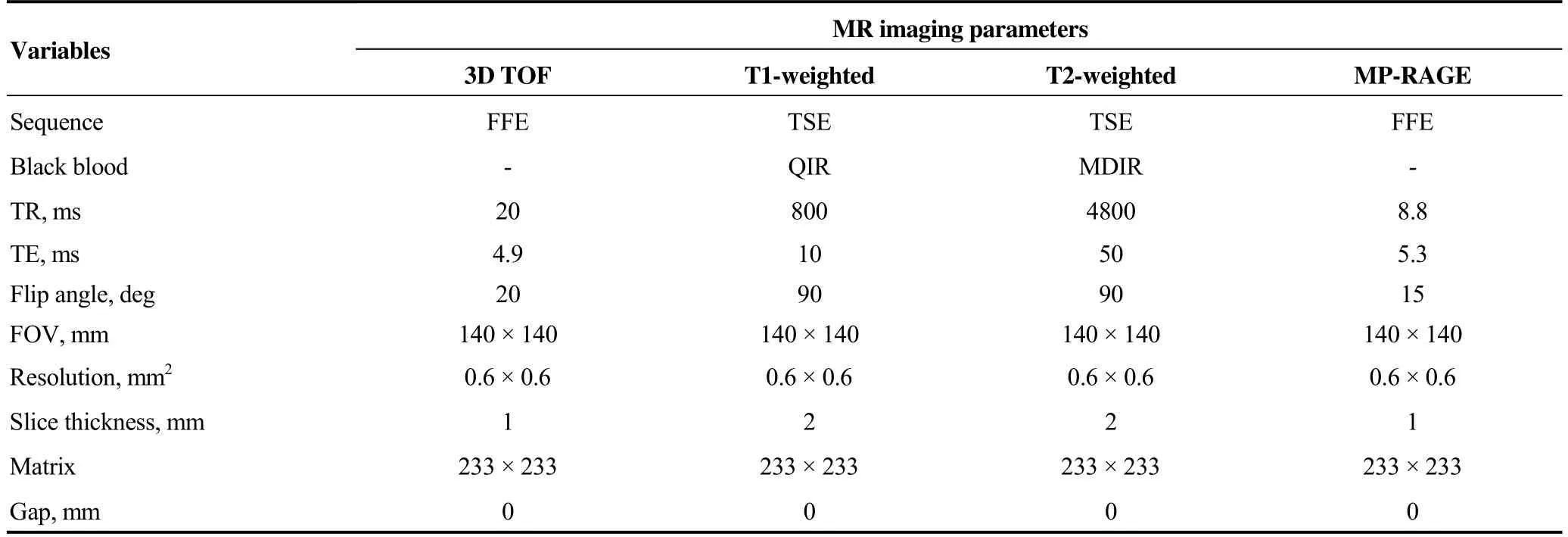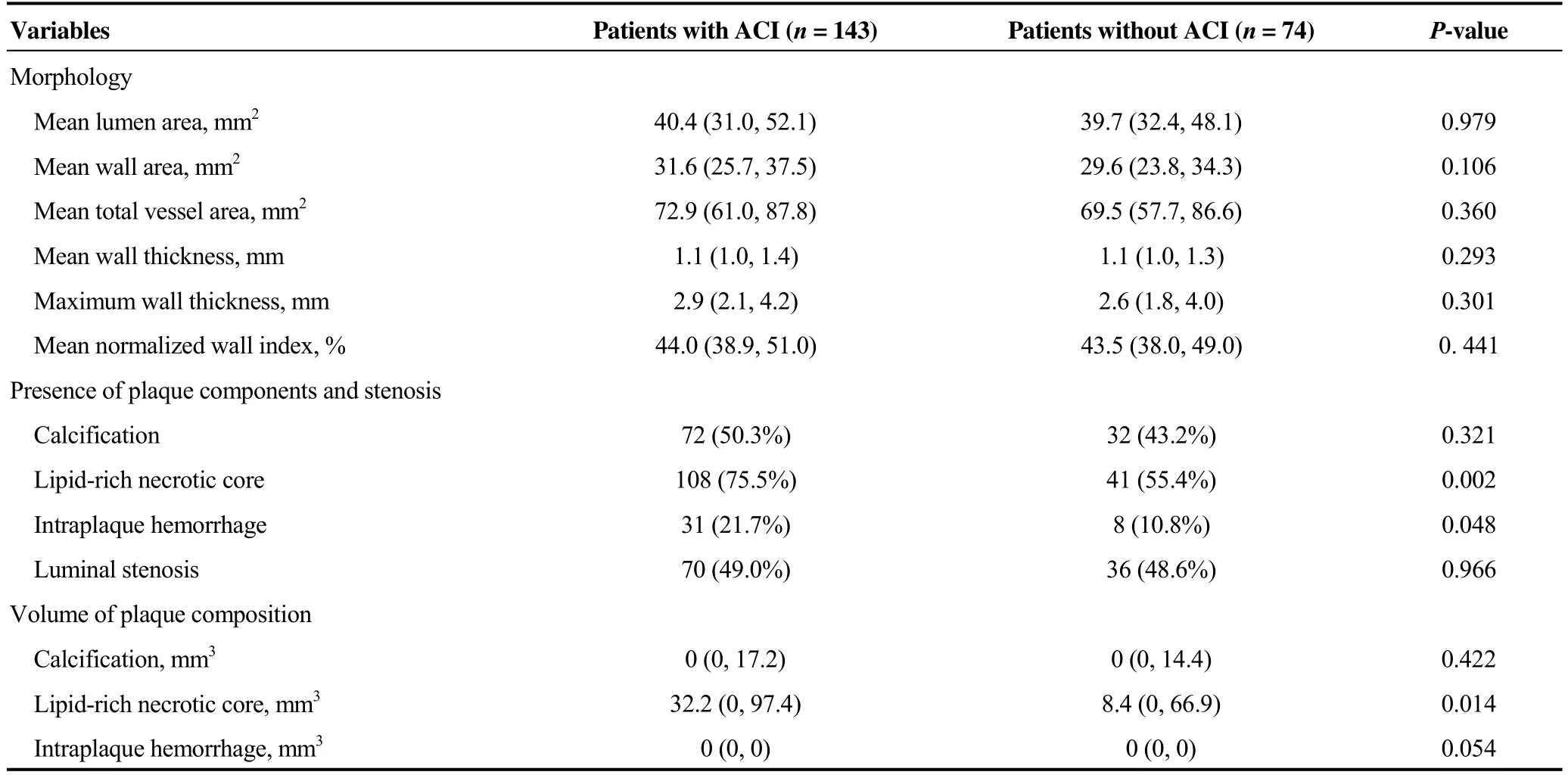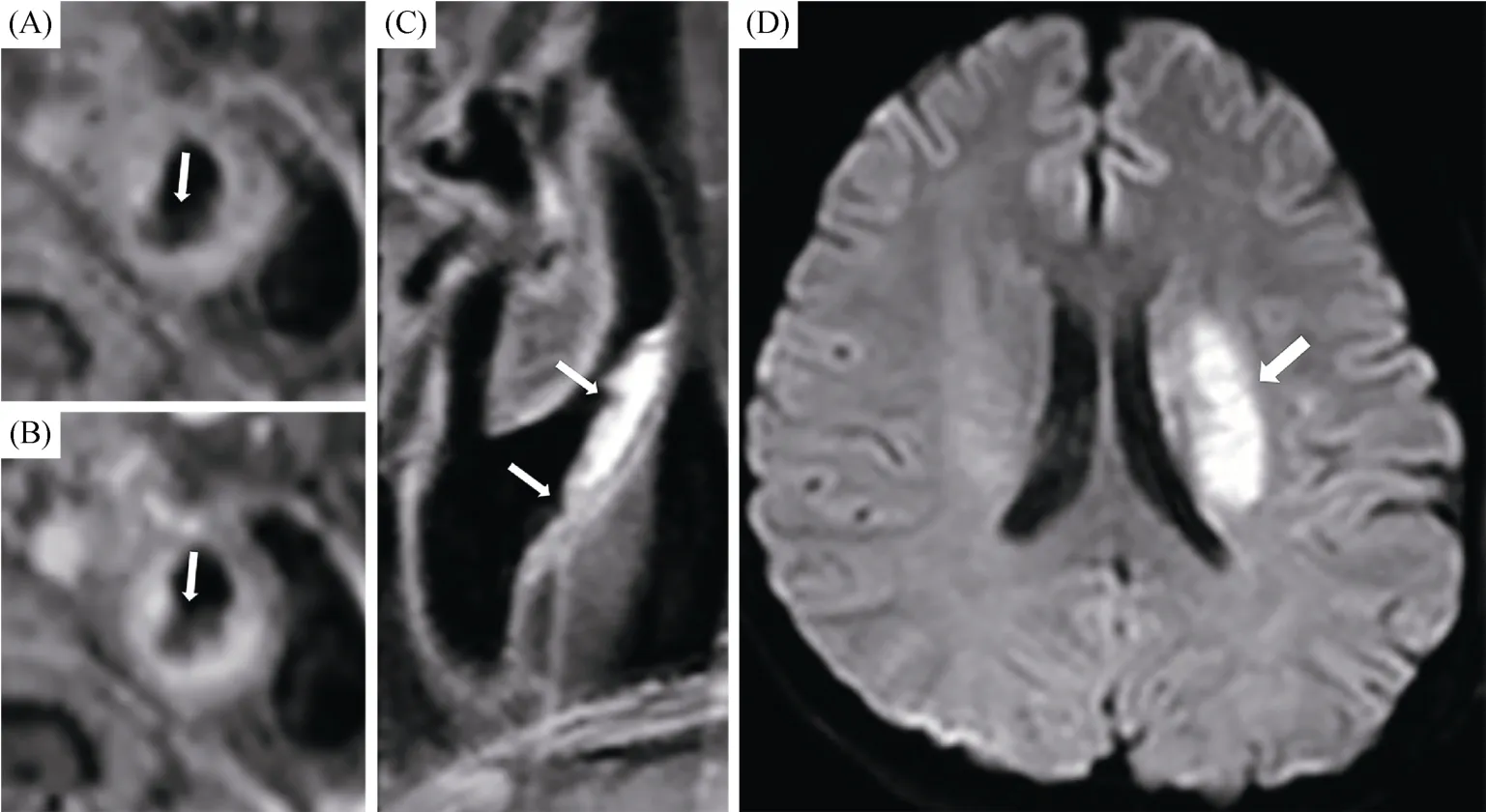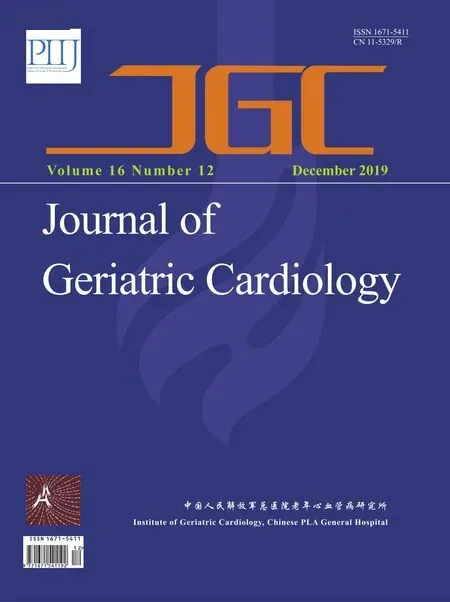Irregular surface of carotid atherosclerotic plaque is associated with ischemic stroke: a magnetic resonance imaging study
Dan ZHOU, Jin LI, Dong LIU, Li-Ya JI, Na-Qin WANG, Jie DENG, Ji-Chen WANG,#, Min YE, Xi-Hai ZHAO
1Department of Radiology, BenQ Medical Center, the Affiliated BenQ Hospital of Nanjing Medical University, Nanjing, China
2Department of Radiology, the Affiliated BenQ Hospital of Nanjing Medical University, Nanjing, China
3Department of Neurology, BenQ Medical Center, the Affiliated BenQ Hospital of Nanjing Medical University, Nanjing, China
4Center for Biomedical Imaging Research, Department of Biomedical Engineering, Tsinghua University School of Medicine, Beijing, China
Abstract Objective To determine the association between the irregularity of carotid plaque surface using multidimensional magnetic resonance imaging (MRI) of ipsilateral acute cerebral infarction (ACI) cases. Methods Patients with recent cerebrovascular symptoms (stroke or transient ischemic attack < 2 weeks) and atherosclerotic plaque in at least one carotid artery were diagnosed by B-mode ultrasound imaging (intima-media thickness ≥ 1.5 mm) and recruited for the present study. Irregular surface was defined when plaque surface was uneven with high and low fluctuation or plaque with surface ulceration. The irregularity of carotid plaque surface was determined on axial or oblique images alone (single-dimension) and on both axial images and oblique images (multidimensions), separately. Univariate and multivariate logistic regression analyses were performed to calculate the odds ratio (OR) and the corresponding 95% CI of the irregular plaque surface in discriminating the presence of ipsilateral ACI. Results A total of 217 included subjects (mean age: 60.7 ± 10.2 years, 149 men) were recruited and 89 (41.0%), 88 (40.6%) and 118 (54.4%) of them exhibited irregular plaque surface on axial, oblique and multidimensional MR images, respectively. The OR of irregularity of the plaque surface was determined by multidimensional MRI to be 5.88 (95% CI: 3.16-10.96, P < 0.001) in discriminating the presence of ipsilateral ACI. Following adjustment for clinical confounding factors, this association remained statistically significant (OR = 5.65, 95% CI: 2.53-12.60, P < 0.001). The analysis included further adjustment for the presence of lipid-rich necrotic core, intraplaque hemorrhage and stenosis and the results included that this association also remained statistically significant (OR = 6.08, 95% CI: 2.52-14.68, P < 0.001). Conclusions The irregular plaque surface was determined by multidimensional MRI as an independent indicator for ipsilateral acute cerebral infarction.
Keywords: Atherosclerosis; Carotid artery; Magnetic resonance imaging; Surface irregularity
1 Introduction
Stroke has become the first cause of death in the Chinese population.[1]Carotid vulnerable atherosclerotic plaque is regarded as one of the major etiologies for ischemic stroke.[2,3]Therefore, characterization of carotid plaque vulnerability prior to onset of events is important for stroke prevention. Atherosclerotic plaques that are prone to disruption are characterized not only by compositional features, such as large lipid-rich necrotic core (LRNC) and intraplaque hemorrhage, but also by the irregularity of plaque surface which is defined as surface fluctuation from 0.3 mm to 0.9 mm or ulcerated surface.[4]
Several studies have demonstrated a significant correlation between irregular or ulcerated surface of atherosclerotic plaque and cerebral infarction. The irregularity of plaque was initially described in a small group of patients in 1968, which received surgical removal of the ulcerated plaque and achieved relief of the ipsilateral symptoms.[5]Therefore, superficial ulceration plaques may be the pathological basis of thrombotic artery embolism and this mechanism was highlighted by a study showing that in up to 12.6% embolic transient ischemic attacks were from ulcerated plaques.[6]Furthermore, the risk of stroke in patients with ulcerated plaques was 1.24 to 3.43 times higher compared with that of the non-ulcerated plaques.[7]A multiparametric analysis has shown a significant association between ulcerated carotid plaque and ipsilateral transient ischemia attack or stroke.[8]Moreover, plaques with irregular surface and without a clear ulceration have also been shown to be associated with an increased risk for stroke.[9]As such, the accurate assessment of surface irregularity of carotid plaques is warranted for improving the determination of ischemic stroke risk.
The features of plaque surface can be characterized by multiple imaging modalities, such as computed tomographic angiography (CTA) and ultrasound. However, CTA could not provide the key compositional features, while ultrasound is less capable of detecting additional, more distally located (“tandem”) stenoses than CTA or magnetic resonance angiography.[10]Two-dimensional magnetic resonance (MR) vessel wall imaging has been well proven as an ideal imaging approach for determining the morphological and compositional characteristics in carotid artery plaques validated by histology.[11,12]This technique primarily provides information regarding the single dimension of axial MR images for the use of image interpretation, which may limit the capability of detecting irregular surface, particularly in the longitudinal dimension. Previous studies have shown that the addition of the oblique MR imaging (MRI) scan for carotid arteries can improve the identification of ulceration in carotid atherosclerotic plaques.[13]However, it is still unknown whether the oblique MR scan possesses the appropriate sensitivity for carotid surface irregularity in determining ipsilateral ischemic stroke risk. We hypothesized multidimensional MRI combing axial and oblique images may have incremental value in determining the risk of ipsilateral ischemic stroke.
The present study sought to determine the association between surface irregularity of carotid plaque and acute ischemic stroke by multidimensional MRI.
2 Methods
2.1 Study population
In this prospective study, patients with recent cerebrovascular symptoms (stroke or transient ischemic attack < 2 weeks) and carotid artery atherosclerotic plaques were recruited and assessed by B-mode ultrasound imaging (intima-media thickness ≥ 1.5 mm). The exclusion criteria were as follows: (1) cardiogenic stroke; (2) hemorrhagic stroke; (3) history of radiation therapy in the neck; (4) claustrophobia or any contraindication to MRI examination; and (5) severe disturbance of consciousness, such as coma. Clinical information including age, sex, body mass index (BMI), history of diabetes, hypertension, coronary heart disease, smoking, antihypertension and lipid-lowering treatment, lipoprotein (high density lipoprotein, low density lipoprotein, total cholesterol, and triglyceride) levels and blood pressure were collected from the medical records prior to carotid MRI for all patients. The present study protocol was approved by the institutional review board and each patient provided a written consent form prior to participating in the study.
2.2 Imaging acquisition
The patients who participated in the present study underwent carotid and brain MRI on 3.0T MR scanner (Achieva TX, Philips Healthcare, Best, The Netherlands) with 8-channel carotid coil. The carotid MRI protocol included three-dimensional time-of flight, T1-weighted, T2-weighted, and Magnetization Prepared Gradient Recalled Echo imaging sequences. The imaging parameters are detailed in Table 1. The localization of the carotid plaque imaging is centered to the bifurcation of the carotid artery index, which is defined as arteries responsible for the symptoms. A routine brain imaging protocol, including T1-weighted, fluid attenuated inversion recovery and diffusion weighted imaging sequences, was used to assess the cerebral infarct.

Table 1. The parameters used for carotid artery MR imaging.
2.3 Image analysis
The MR images were interpreted by two radiologists with > 3 years’ experience in vascular imaging using custom-designed software of CASCADE (University of Washington, Seattle, USA). The research reached a consensus with regard to the interpretation of the images. A 4-point scale was adopted according to the sharpness and contrast between the vessel wall and the surrounding fat tissues as follows: (1) poor; (2) marginal; (3) good; and (4) excellent. The MR images with an image scale ≥ 2 were interpreted. The boundaries of the carotid artery lumen and wall were traced manually and the areas for lumen, wall and total vessel and wall thickness were measured. The presence or absence and the volume of each plaque composition, such as calcification, LRNC and intraplaque hemorrhage were determined by utilizing published criteria.[10]The irregularity of plaque in symptomatic carotid arteries was analyzed in two separate rounds of review. Irregular surface suggests that the plaque surface is uneven with high and low fluctuation,[4]or plaque with surface ulceration which was identified on multi contrast MR vessel wall images with published criteria.[14,15]By contrast, smooth surface indicated that the plaque surface was smooth and homogeneous.[16]In the first round of review, the presence or absence of irregular surface of carotid plaque was identified by two reviewers with consensus on the multi contrast MR axial images (16 slices), who were blinded to carotid oblique MR images (5 slices), brain MR images and clinical information. Following one month of time interval, in the second round of review, the two reviewers determined the irregularity of plaques on both multi contrast axial images and oblique T1-weighted images (multi dimensions). The reviewers reached consensus and were blinded to brain MR images and clinical information. The presence/absence of acute cerebral infarction (ACI) of anterior circulation in the internal carotid artery supply territory on diffusion weighted imaging images was also assessed.
2.4 Reproducibility
A total of 50 patients were randomly selected for intra-reader and inter-reader reproducibility testing and/or assessing plaque surface irregularity using single dimensional and multidimensional MR images. The assessment of the inter-reader reproducibility was performed by two reviewers who assessed the plaque surface irregularity independently, whereas the assessment of the intra-reader reproducibility was performed by one reviewer who assessed surface irregularity twice with a time interval of three months to minimize the memory bias.
2.5 Statistical analysis
The continuous variables were described as mean and standard deviation and the categorical variables were presented as frequencies. Carotid plaque features were compared between subjects with and without ipsilateral ACI using the independentttest, the Mann-WhitneyUtest, or the Chi-square when appropriate. The odds ratio (OR) and corresponding 95% CI of plaque surface irregularity was estimated for discriminating the presence of ipsilateral ACI using univariate and multivariate logistic regressions, whereas the clinical characteristics of the study population, carotid plaque morphological and compositional features were also taken into account. Cohen’s Kappa analysis was utilized to determine the intra-reader and inter-reader agreement in evaluating plaque surface irregularity. AP-value lower than 0.05 (P< 0.05) was considered as statistically significant. The statistical analyses were carried out using the SPSS version 19 (IBM Corporation, Armonk, New York, USA).
3 Results
In total, 241 patients were recruited at the Tsinghua University between January 2011 and December 2014. A total of 24 out of the 241 recruited patients were excluded due to poor image quality. The remaining 217 patients exhibited a mean age of 60.7 ± 10.2 years. A total of 149 (68.7%) patients were male and 143 (65.9%) had ACIs. The clinical data are described in detail in Table 2. The patients with ipsilateral ACIs exhibited significantly higher incidence of coronary heart disease (15.4%vs.2.7%,P= 0.010) and antihypertension treatment (62.2%vs.39.2%,P= 0.018) compared to those without ACIs. No significant differences were found in the other clinical risk factors between the patients with and without ACIs (allP> 0.05).
3.1 Characteristics of carotid plaques as determined by MRI
The results of the comparison of the plaque features between patients with and without ACIs are summarized in Table 3. The patients with ipsilateral ACIs exhibited significantly higher prevalence of LRNC (75.5%vs.55.4%,P= 0.002) and intraplaque hemorrhage (21.7%vs.10.8%,P= 0.048) compared with those without ACIs. The patients with ipsilateral ACIs exhibited significantly higher LRNC volume [32.2 (0, 97.4)vs.8.4 (0, 66.9),P= 0.014] compared with those without ACIs. No significant differences were noted in other plaque compositions between patients with and without ACIs (allP> 0.05).

Table 2. Clinical characteristics of the study population.

Table 3. Carotid plaque morphological and componential features.
3.2 Irregular plaque surface and ipsilateral ACI
A total of 89 (41.0%) plaques were found to have irregular surface including irregular plaques (n= 79) and ulcerated plaques (n= 10) as determined by axial MRI. A total of 88 (40.6%) plaques were found to have irregular surface including irregular plaques (n= 81) and ulcerated plaques (n= 7) as determined by oblique MRI. In contrast to these observations, the multidimensional MRI (both axial and oblique MR images) revealed 118 (54.4%) plaques that were found to have irregular surface including irregular plaques (n= 100) and ulcerated plaques (n= 18). The OR of irregularity for plaque surface was determined by multidimensional MRI was estimated to 5.88 (95% CI: 3.16-10.96,P< 0.001) in discriminating the presence of ipsilateral ACI. Following adjustment for the parameters age, sex, BMI, history of diabetes, hypertension, coronary heart disease, smoking, antihypertension treatment and lipid-lowering treatment, this association remained significant (OR = 5.65, 95% CI: 2.53-12.60,P< 0.001). Following further adjustment for the presence of LRNC, intraplaque hemorrhage and stenosis, this association also remained statistically significant (OR = 6.08, 95% CI: 2.52-14.68,P< 0.001). Table 4 presents the results of logistic regression analysis. Figure 1 represents an example of a patient with irregu- lar plaque surface in the left carotid artery and ipsilate- ral ACI.

Table 4. Logistic regression analysis of risk factors for acute cerebral infarction.

Figure 1. Irregular carotid plaque surface on multidimensional MR images and acute ischemic infarct. An example of a 64-year old male patient who had atherosclerotic plaques in the left internal carotid artery and ipsilateral acute ischemic infarct [white arrow on diffusion weighted imaging (D) image]. The left carotid plaque indicated irregular surface on the white arrow at the axial T1-weighted MR image (A), white arrow at the axial T2-weighted MR image (B) and white arrows at the oblique T1-weighted image (C) images, respectively. MR: magnetic resonance.
3.3 Reproducibility
The intra-reader agreement resulted in the identification of the presence of irregular plaque surface in axial, oblique and multidimensional MR images and the kappa value was 0.79 (P< 0.001), 0.83 (P< 0.001) and 0.76 (P< 0.001), respectively. The inter-reader agreement was established for the assessment of the presence of irregular plaque surface in axial, oblique and multidimensional MRI. The kappa value was 0.77 (P< 0.001), 0.70 (P< 0.001) and 0.72 (P< 0.001), respectively.
4 Discussion
In the present study, the value of carotid plaque surface irregularity was determined by multi dimensional MRI including axial and oblique vessel wall images for determining ipsilateral acute ischemic stroke risk. The irregular surface of carotid plaques was determined by single and multiple dimensional MRI and was independently associated with the presence of ipsilateral ACI. Multidimensional MRI exhibited incremental value in discriminating risk of ipsilateral ACI. The findings suggested that characterizing carotid plaque irregularity by multiple dimensional MRI was valuable for determining the indicator of ipsilateral ACI.
The present study demonstrated that the surface irregularity of carotid plaques that was determined by the MR vessel wall imaging was significantly associated with ipsilateral ACI. The findings are consistent with previous studies. In a high-resolution B-mode ultrasound study that enrolled 1939 patients, the 5-year ischemic stroke risk among those with irregular plaque surface was 8.5% compared with 3.0% noted for the patients with regular surface.[17]An additional ultrasound study further demonstrated that the mean surface irregularity index was significantly higher for plaques with ipsilateral hemispheric symptoms than those for asymptomatic plaques (1.89 radians/mmvs.1.67 radians/mm,P= 0.03).[18]Troyer,et al.[19]demonstrated a significant correlation between surface irregularity and transient ischemic attack or stroke (P< 0.01). A study by Rothwell,et al.[9]reported that angiographic plaque surface irregularity was an independent predictor of ipsilateral ischemic stroke on medical treatment used for all degrees of stenosis (HR = 1.80, 95% CI: 1.14-2.83,P= 0.01). Histologically, the irregular surface reflects either ulceration or calcium nodule protruding to the lumen,[20,21]suggesting that the plaque surface irregularity may be an indicator for plaque vulnerability.
The present study demonstrated that the addition of a two-dimensional black-blood sequence improved the strength of plaque surface irregularity in discriminating ipsilateral ACI. This sequence was used in order to acquire oblique carotid images into the traditional multicontrast carotid MRI protocol. Traditional multicontrast vessel wall imaging only provides axial view for carotid arteries, whereas the oblique images enable evaluation of the plaque surface at the longitudinal view. This multidimensional imaging approach may allow the comprehensive assessment of the irregularity of carotid plaques. Carotid MR vessel wall imaging acquired at sagittal orientation has been used for evaluating the surface features of carotid plaques in previous studies.[19]Yu,et al.[13]found that the use of the longitudinal black-blood cardiovascular MR angiography sequence in addition to the axial cardiovascular MR images in round 2, improved the sensitivity to 80% for ulcers that were at least 6 mm3in volume compared with 30% noted in round 1. In addition, it enhanced the sensitivity to 52.4% for all ulcers compared with 23.8% noted in round 1 (axial cardiovascular MR images alone). These data indicated that the combination of oblique and axial MR images may possess prognostic value for the identification of plaque surface irregularity in carotid arteries.
The present study utilized two-dimensional multicontrast MR vessel wall imaging to determine the irregularity of carotid plaque surface. Currently, investigators proposed three-dimensional MR vessel wall imaging techniques, such as motion sensitized driven equilibrium rapid gradient echo,[22]volumetric isotropic turbo spin echo acquisition[23]/ sampling perfection with application optimized contrasts using different flip-angle evolution,[24]and simultaneous noncontrast angiography and intraplaque hemorrhage.[25]The iso-tropic resolution and multiple planar reconstructions can be applied at any orientation of the imaging data without tissue distortion and can offer significant benefits in the imaging analysis. These three-dimensional imaging sequences may be ideal techniques for the evaluation of plaque surface in future studies.
4.1 Limitations
The present study has several limitations. Firstly, we only focused on the assessment of the single side of the carotid arteries. An irregular surface may be present at the bilateral carotid plaques. The irregular surface in the bilateral carotid arteries can be investigated in future studies. Secondly, the surface features of the atherosclerotic plaque included surface calcification. Surface calcification indicated low density and may lead to surface irregularity on black blood images. Previous evidences have shown that plaques with surface calcification are prone to disruption.[26-28]Finally, the surface irregularity of this study was only observed by naked eyes and this approach could be further optimized and validated by histological analysis.
4.2 Conclusions
The plaque surface irregularity was determined by multidimensional magnetic resonance images by combining the axial with oblique images. This method offers higher predictive value for ipsilateral ACI than single axial or oblique imaging, suggesting that multidimensional evaluation of plaque irregularity is valuable for determining the risk of ipsilateral acute ischemic events.
Acknowledgments
This study was supported by the National Natural Science Foundation of China (No. 81771825), Beijing Municipal Science and Technology Commission (D1711000 03017003), and Ministry of Science and Technology of China (2017YFC1307904). All authors had no conflicts of interest to disclose.
 Journal of Geriatric Cardiology2019年12期
Journal of Geriatric Cardiology2019年12期
- Journal of Geriatric Cardiology的其它文章
- Quantitative flow ratio and intravascular ultrasound guided percutaneous coronary intervention of left anterior descending lesion concomitant with severe coronary myocardial bridge
- Delayed cardiac tamponade after simultaneous transcatheter atrial septal defect closure and left atrial appendage closure device implantation: a particular case report
- Coarctation of the aorta in twins with severe hypertension
- Risks of incident heart failure with preserved ejection fraction in Chinese patients hospitalized for cardiovascular diseases
- Pacemaker therapy in very elderly patients: survival and prognostic parameters of single center experience
- Hypoxia promotes pulmonary vascular remodeling via HIF-1α to regulate mitochondrial dynamics
